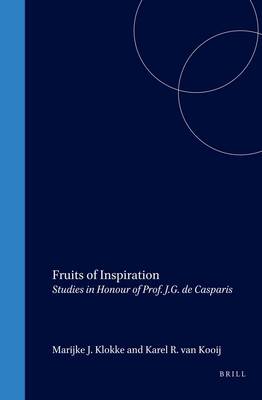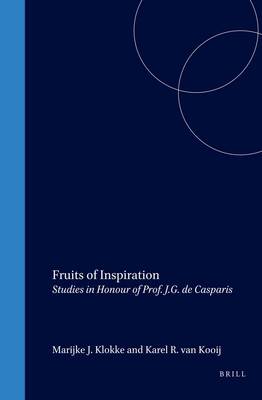
- Afhalen na 1 uur in een winkel met voorraad
- Gratis thuislevering in België vanaf € 30
- Ruim aanbod met 7 miljoen producten
- Afhalen na 1 uur in een winkel met voorraad
- Gratis thuislevering in België vanaf € 30
- Ruim aanbod met 7 miljoen producten
Zoeken
Fruits of Inspiration
Studies in Honour of Prof. J.G. de Casparis
€ 253,45
+ 506 punten
Omschrijving
A rich collection of lengthy and thorough articles about such a broad field as the history, art and archeology of South and Southeast Asia, this volume is a worthy tribute to a great scholar. Professor J. G. de Casparis has lectured and published widely both at the School of African and Oriental Studies in London and at the Departments of South and Southeast Asian Studies in Leiden. Inspired by his lifelong devotion to this field, his former colleagues and students, now spread over many countries in Asia and the West, present the selected fruits of their research as a token of friendship and admiration.
Epigraphy is the main theme in most of the thirty articles contained in this volume, but others focus on the Borobudur, the Old-Javanese calendar, books and writing materials, Buddhist iconography, and important issues such as the nature of the 'lasting relationship' between South and Southeast Asia, particularly in pre-Islamic times. All authors share the outspoken historical and textual approach, so characteristic of the work of Professor de Casparis and his circle, thus giving this book its inner coherence and consistency.
This book is not just a random collection of papers. The scope and richness of the contributions will not fail to appeal to new generations of scholars and students working in this field, and as such this book is expected to fulfill its own role in the transmission of knowledge regarding the great civilizations of ancient South and Southeast Asia.
Epigraphy is the main theme in most of the thirty articles contained in this volume, but others focus on the Borobudur, the Old-Javanese calendar, books and writing materials, Buddhist iconography, and important issues such as the nature of the 'lasting relationship' between South and Southeast Asia, particularly in pre-Islamic times. All authors share the outspoken historical and textual approach, so characteristic of the work of Professor de Casparis and his circle, thus giving this book its inner coherence and consistency.
This book is not just a random collection of papers. The scope and richness of the contributions will not fail to appeal to new generations of scholars and students working in this field, and as such this book is expected to fulfill its own role in the transmission of knowledge regarding the great civilizations of ancient South and Southeast Asia.
Specificaties
Betrokkenen
- Uitgeverij:
Inhoud
- Aantal bladzijden:
- 566
- Taal:
- Engels
- Reeks:
- Reeksnummer:
- nr. 11
Eigenschappen
- Productcode (EAN):
- 9789069801377
- Verschijningsdatum:
- 1/01/2001
- Uitvoering:
- Hardcover
- Formaat:
- Genaaid
- Afmetingen:
- 183 mm x 246 mm
- Gewicht:
- 1746 g

Alleen bij Standaard Boekhandel
+ 506 punten op je klantenkaart van Standaard Boekhandel
Beoordelingen
We publiceren alleen reviews die voldoen aan de voorwaarden voor reviews. Bekijk onze voorwaarden voor reviews.







